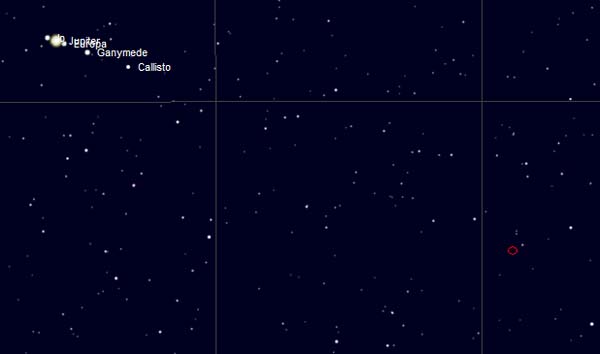
The chart is to illustrate the enormous distance of Himalia (position marked by the red circle) to Jupiter and the four Galilean moons. The width of the grid is 30 arc minutes.
Himalia, Jupiter's "fifth" moon
Oktober 2009
Jupiter has quite a number of satellites, of which probably all of us have observed the four brightest ones, the Galilean moons Ganymede, Europa, Callisto, and Io. These have diameters between 3000 and 5000 km and are about 5th magnitude, which makes them easy targets even in binoculars.
After these four Galilean moons, there is a
big gap in terms of size and brightness. The next biggest moon is Amalthea,
which has 14th (!) magnitude and a diameter of about 170 km. Amalthea is one of
the inner moons, orbiting very close to Jupiter and rendering an observation
hence quite difficult. Himalia is of similar size and of mag 14.8, but it is the
other extreme: It is one of the outer moons with up to 40 arc minutes (!)
distance from Jupiter. This makes sure that the bright disk of Jupiter is not
disturbing. On the other hand, Jupiter may not be of assistance in finding the
moon. A precise ephemeris for the time of observation and deep star maps are
therefore a requirement. Ephemerides can be obtained from the Horizons
server at JPL/NASA.
You will further need enough aperture and good seeing to be able to reach a
limiting magnitude that is sufficient to identify Himalia.
Yesterday, on October 22 2009, I started my third attempt, which was finally successful. Last week during my first attempt, I had taken erroneously the coordinates of the day before. On Monday during my second attempt, the seeing was horrible, bloating up stars and moons and lowering the limiting magnitude to a poor mag 14.0 (with a 22" Dob). Yesterday, everything was OK, seeing was acceptable and the limiting magnitude good enough to pinpoint Himalia precisely at the position indicated by Horizons. It was visible as a faint point source that could be held permanently with averted vision. To backup my identification of Himalia, I verified on a DSS printout that there are no stars brighter than mag 17 at the indicated position.
|
|
The chart is to illustrate the enormous distance of Himalia (position marked by the red circle) to Jupiter and the four Galilean moons. The width of the grid is 30 arc minutes. |
As compared with Triton, the biggest moon of Neptune, or the brigher Uranus moons Oberon, Titania, or Ariel, Himalia is quite a bit more difficult. On the other hand, there is no glaring bright planet disk in the direct vicinity. And, very unusual for planetary moons, the large apparent distance to the planet requires meticulous preparation with charts and coordinates.
By the way, the motivation to try observing Himalia came from
an observing report by Steve
Gottlieb.
![]()